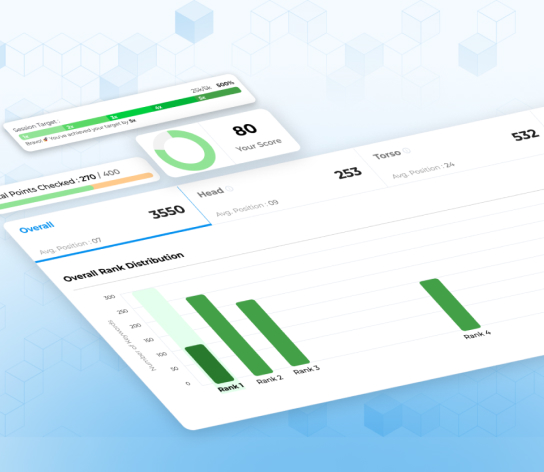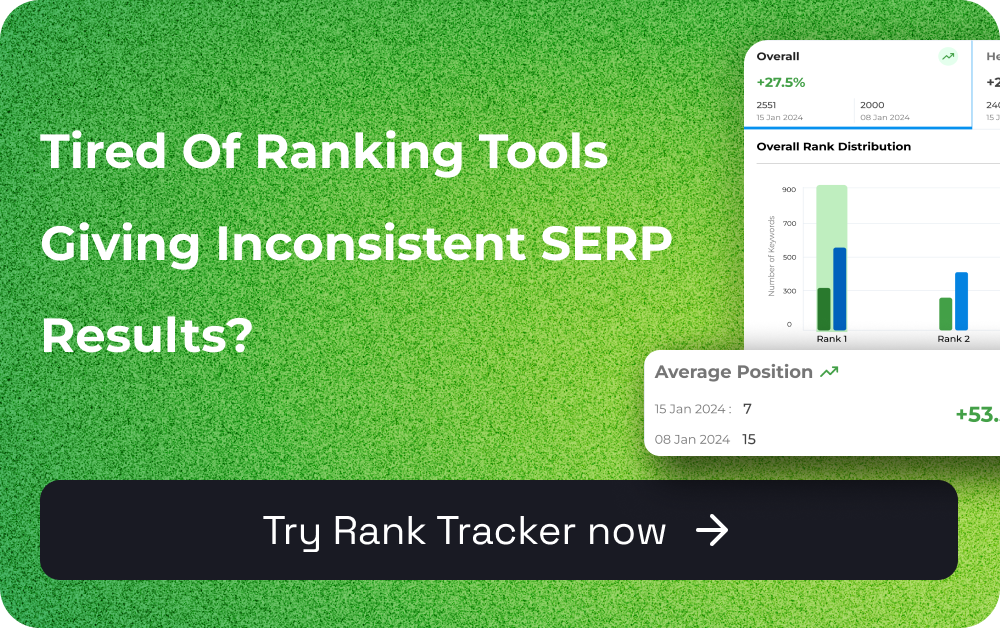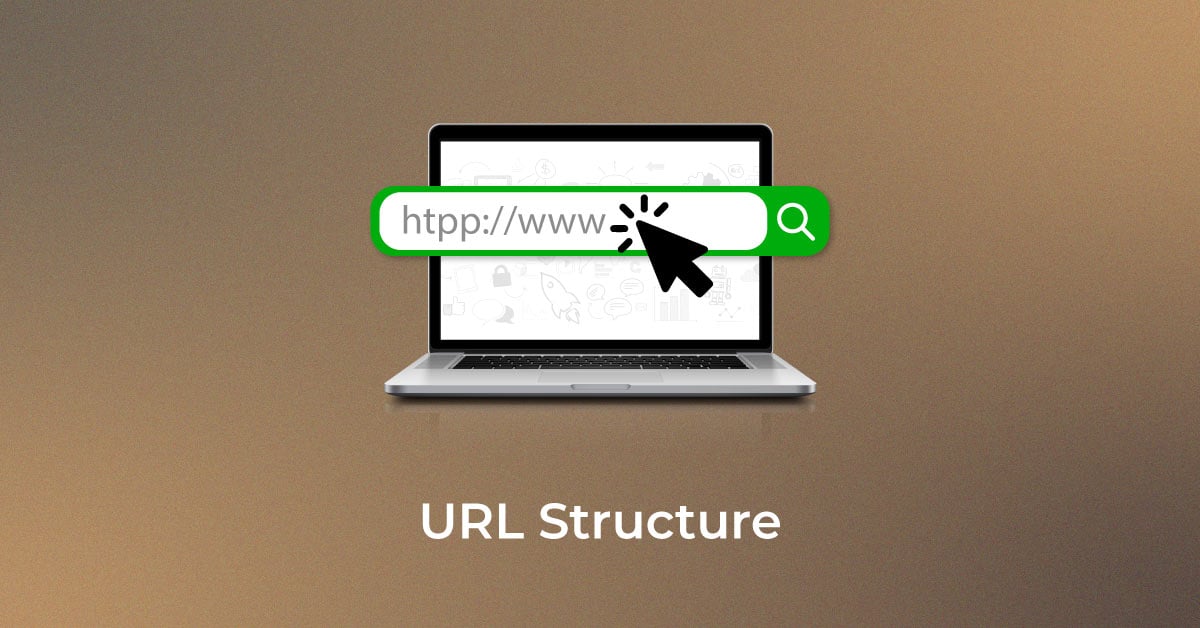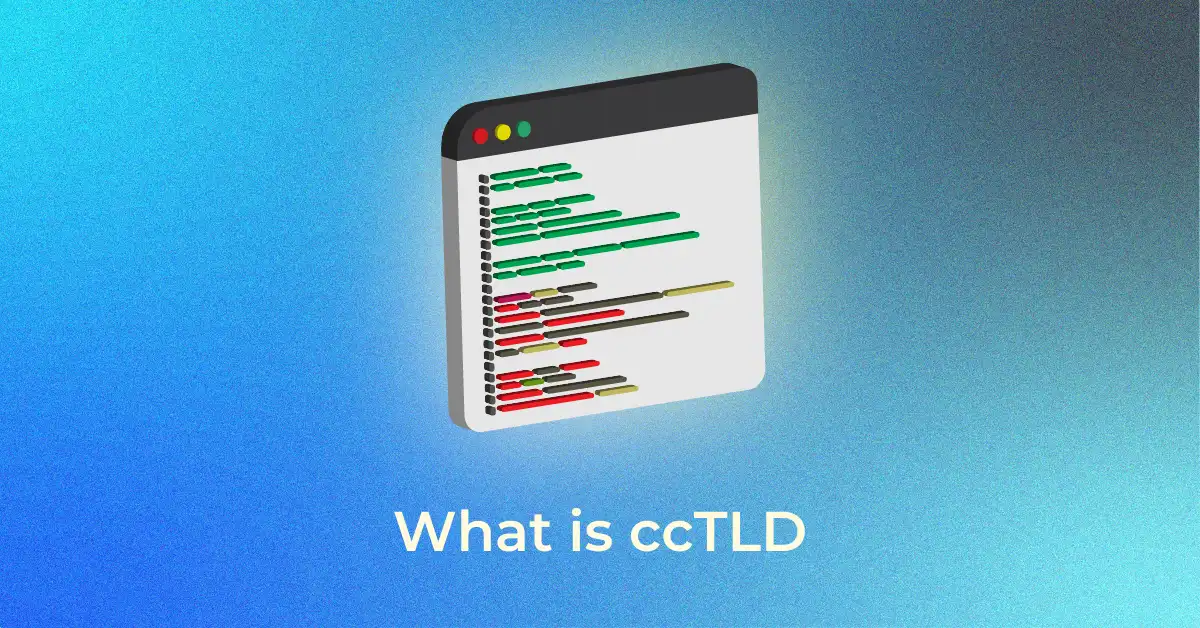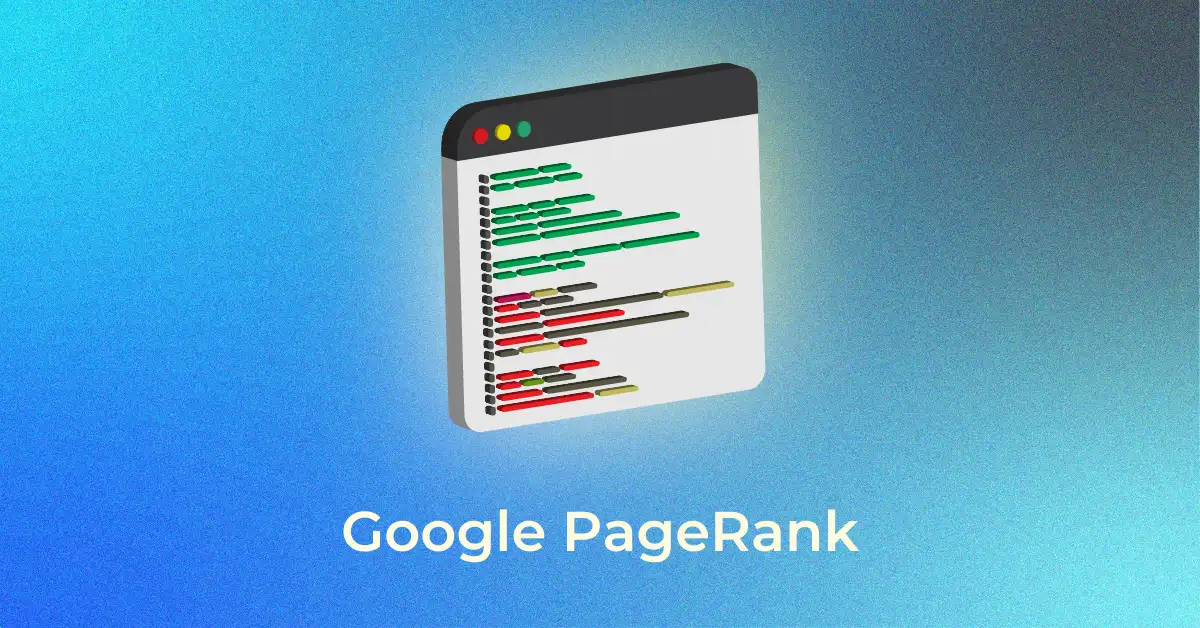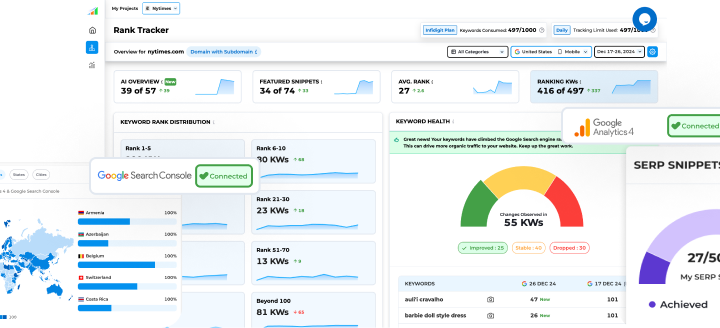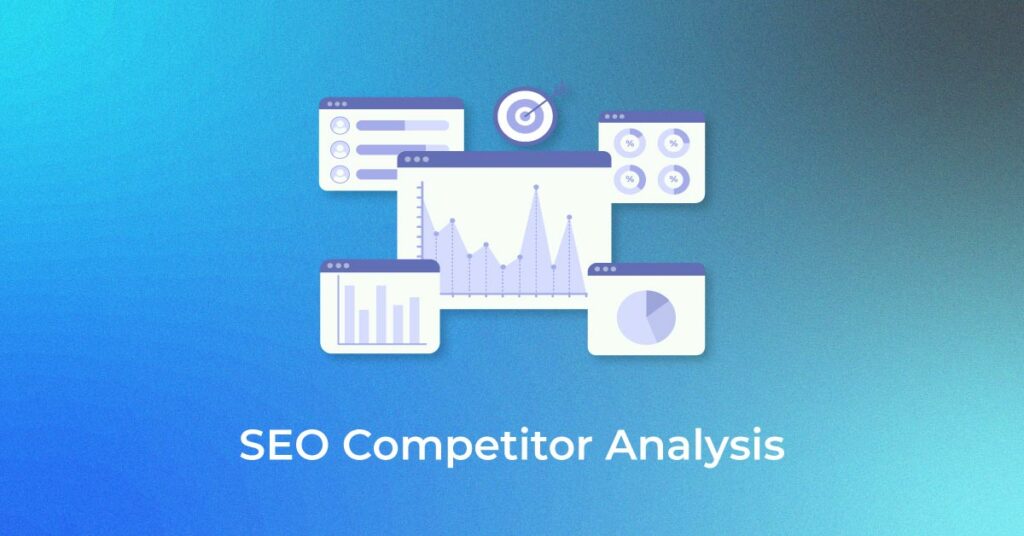SEO competitor analysis is analysing the SEO strategies that your competitors are leveraging to rank higher in SERP. This would include deciphering their links, content, on-page SEO techniques, and other tactics. This helps to discover unique SEO optimisation opportunities that you may have not previously touched upon.
What is SEO Competitor Analysis?
SEO competitor analysis is the process of evaluating your competitors’ SEO strategies to identify strengths, weaknesses, and opportunities for your own website. It involves analyzing factors like keywords, content, backlinks, site structure, and technical SEO to understand how competitors rank higher in search results.
By conducting competitor analysis for SEO, you gain insights into what’s working for others in your industry and how you can optimize your own strategy to outperform them. This helps in refining keyword targeting, improving content quality, and building a stronger backlink profile.
For example, if a competitor ranks higher for a high-traffic keyword, analyzing their content, backlinks, and on-page SEO tactics can help you adjust your approach to compete more effectively.
Why is SEO Competitor Analysis Important?
SEO competitor analysis gives you a deeper understanding of your industry, helping you identify gaps you can fill. By assessing where your competitors stand and comparing it to your position, you can uncover opportunities to strengthen your strategy and improve your rankings. Even if your website ranks among the top five search results for key industry terms, competitors are constantly working to outrank you by capitalizing on your weaknesses.
A well-structured competitor analysis helps you pinpoint what your rivals are doing better—whether it’s securing featured snippets, building a stronger community, or optimizing their content strategy. By analyzing these factors, you can create a data-driven roadmap to refine your SEO efforts and stay ahead in the competition.
How often should you perform Competitor Analysis?
SEO competitor analysis can often be overwhelming due to the sheer efforts that go into it. It is not a one-day task and requires some time to analyse and come up with an adequate strategy.
In order to save time and efforts, we would recommend performing SEO competitor analysis quarterly. You can adhere to a time frame that best fits your needs. Interestingly, a study from Databox states that SEO agencies and experts preferred carrying out competitor analysis monthly or quarterly.
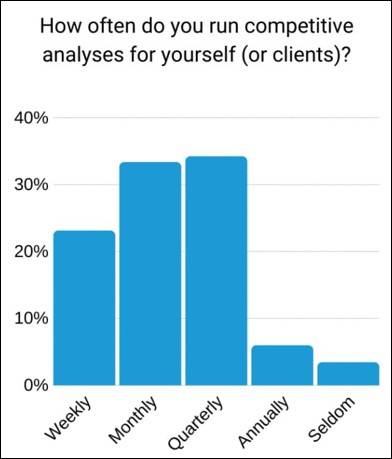
Source: Databox
Conducting Competitive Analysis After Major Algorithm Updates
Search engine algorithms constantly evolve, impacting website rankings and traffic. After a major Google algorithm update, conducting a fresh competitor analysis for SEO is essential to understand how ranking factors have shifted and how your competitors are adapting.
Analyze changes in keyword rankings, content performance, backlink profiles, and technical SEO to identify what strategies are working post-update. If a competitor gains visibility while your rankings drop, assessing their adjustments can help you refine your SEO strategy accordingly.
Regularly monitoring competitors after updates ensures you stay ahead in search results and adapt to new ranking factors before they significantly impact your traffic.
How to Find Your SEO Competitors
In order to start an SEO competitor analysis, we first need to be aware of who our actual competitors are. You most likely already know who your competitors are in the industry in traditional marketing. However, when it comes to SEO, the chances are that your competitors won’t be the same.
Here’s how you can find your true SEO competitors
-
Google SERP
The Google SERP is the best bet for finding SEO competitors. First, identify the keywords that you want to rank for. Now search for these keywords on Google. The websites that are ranking on the first page of the search engine are your competitors. You might notice some repetitive competitors ranking for most of your queries. These are the ones you need to keep a close eye on. Create a list of such 5-10 competitors, according to your preference.
-
By Using SEO Tools
Alongside Google SERP, which is a manual process, you can also use specific specialized SEO tools for finding your competitors. Ahrefs and SEMRush, both are reputed tools that you can use.
-
Manual Search
One of the simplest ways to identify your SEO competitors is through a manual search on Google. By searching for your target keywords, you can see which websites consistently rank on the first page. These are your direct competitors, as they are targeting the same audience and search terms.
To conduct a manual search effectively:
- Use incognito mode to avoid personalized results.
- Search for primary and long-tail keywords relevant to your niche.
- Analyze the top-ranking pages to identify patterns in content, backlinks, and on-page SEO.
This method provides firsthand insights into what’s working for top competitors, helping you refine your SEO strategy accordingly.
Who are Your Actual SEO Competitors?
When conducting competitor analysis for SEO, it’s essential to recognize that your biggest rivals aren’t always large corporations. Sometimes, smaller businesses dominate niche segments by strategically targeting long-tail keywords. While big companies may invest heavily in high-cost keywords, smaller competitors can still capture significant traffic through smart SEO tactics.
Equally important is knowing which websites not to compete with. If your site ranks third for a keyword but is only behind platforms like Wikipedia or Pinterest, attempting to outrank them may not be worth the effort. Instead, focus on keywords where your direct competitors are outperforming you, as those are the areas where you can make meaningful gains in traffic and visibility.
Types of SEO Competitor Analysis
We have collated some important competitor analysis techniques to help you strengthen your search engine optimization results:
-
Keyword Gap Analysis

Source: SEMRush
Keyword gap analysis helps identify the keywords your competitors rank for but you don’t. By analyzing these gaps, you can refine your SEO strategy to target high-value keywords that drive traffic.
To perform this analysis, use tools like SEMrush:
- Navigate to the Keyword Gap section.
- Enter your URL along with competitors’ URLs.
- Review the list of organic, paid, or Google Shopping (PLA) keywords your competitors rank for.
Next, evaluate why your pages aren’t ranking:
- Are these keywords missing from your strategy?
- How does your Domain Authority (DA) & Page Authority (PA) compare to competitors?
- Do your competitors have a stronger backlink strategy for these keywords?
- What type of content format do they use?
Answering these questions will help you bridge keyword gaps and strengthen your search visibility.
-
Find Keywords Your Competitors Have Lost
Tracking keywords your competitors have lost can reveal opportunities to gain an edge in search rankings. When a competitor drops in ranking or loses visibility for a keyword, it may indicate content decay, algorithm updates, or lack of optimization—allowing you to capitalize on their weakness.
To find lost keywords:
- Use SEO tools like Semrush or Ahrefs to track keyword movements.
- Identify pages that previously ranked well but have declined in search results.
- Analyze why they lost rankings—was it due to outdated content, weak backlinks, or a new Google update?
By optimizing content around these lost keywords, you can fill the gap and improve your rankings, gaining traffic that your competitors are no longer capturing.
-
New Keyword Opportunities
Identifying new keyword opportunities is a crucial part of SEO competitor analysis, helping you stay ahead by targeting search terms your competitors might be missing. These keywords could be emerging trends, long-tail variations, or queries triggered by recent algorithm updates.
To find new keyword opportunities:
- Use tools like Google Keyword Planner, Ahrefs, or Semrush to discover trending and low-competition keywords.
- Analyze your competitors’ content to spot gaps in their keyword strategy.
- Monitor Google’s “People Also Ask” and related searches for fresh content ideas.
By targeting new and untapped keywords, you can attract more traffic, gain a competitive edge, and improve your search visibility before others in your industry catch on.
Content Gap Analysis
This is a technique that involves the study of different types of content that your competitors produce. This will give you an insight into how to prepare your content strategy.
Here are few things you need to look out for:
-
Word Count
You can use a tool like Screaming Frog to find the word count of your competitors’ pages. In SEO, content is the king and most often long-form content performs the best. Keep a close eye on the word count of the content that your competitors are uploading. Your goal should be to write content that is equal to or greater than your competitors’ word count.
-
Uniqueness
Simply scraping your competitors’ content and adding it to your page won’t help. You might end up getting penalized by Google for this dreadful attempt. You can take an idea from your competitors to find your content topics, but you need to produce original quality content.
-
Other forms of content
Check whether your competitors use other content generation types, such as infographics, photos, or videos. Google likes it when site owners go out of their way to provide a good user experience. If your competitors use these different forms of content to achieve good rankings, it’s your time to step up the game.
-
Answer based content
You may find some of your competitors appearing on featured snippets. Closely analyze their content and check if they are using question-based queries (answering questions about the content). This answer-based content helps you get an edge over your competitors to appear in featured snippets. It is also good for your voice search SEO.
If you are having a hard time producing quality SEO content, you can reach out to companies that provide SEO content marketing services. This will help you generate SEO-optimised content and help you in your website’s rankings.
-
Content Quality & Type
Assessing content quality and type helps identify gaps and improve your strategy. High-ranking competitors create informative, engaging, and well-structured content that meets user intent. Analyze their formats—blogs, videos, infographics—and evaluate depth, accuracy, and readability. Check user engagement through comments and shares. By enhancing clarity, structure, and uniqueness, you can fill gaps, improve user experience, and boost rankings.
-
Meta Titles and Descriptions
Meta titles and descriptions play a key role in SEO and click-through rates (CTR). Analyzing competitors’ meta tags helps identify gaps in your own optimization. Look for keyword usage, clarity, and engagement level in their titles and descriptions. Strong meta tags are concise, compelling, and optimized for search intent. By refining yours with targeted keywords and persuasive messaging, you can improve visibility, attract more clicks, and enhance rankings.
-
Readability
Readability impacts user experience and SEO rankings. If your content is difficult to read, visitors may leave quickly, increasing bounce rates. Analyzing competitor content helps identify gaps in sentence structure, tone, and formatting. Effective content is clear, concise, and skimmable, using short paragraphs, bullet points, and simple language. By improving readability, you can enhance engagement, retention, and search performance.
-
Featured Snippets
Featured snippets provide quick answers at the top of search results, boosting visibility and traffic. Analyzing competitors’ snippets helps identify content gaps and opportunities to optimize your own. Focus on clear, concise answers, use structured formatting like lists or tables, and target question-based queries. By refining your content, you increase the chances of securing a featured snippet and improving rankings.
Backlink Gap Analysis
This technique involves the study of competitors’ backlinks to determine how strong their backlink profile is. Backlink analysis, also known as link gap analysis, is a fundamental competitor analysis technique. If your competitors have a high-quality backlink profile, ranking above them may be difficult.
-
Common Backlinks
You can use a tool like Ahrefs to find all your competitors’ backlinks. Go to Ahrefs and enter your competitor’s website URL. Now click on the ‘Backlinks’ section to see all their backlinks:
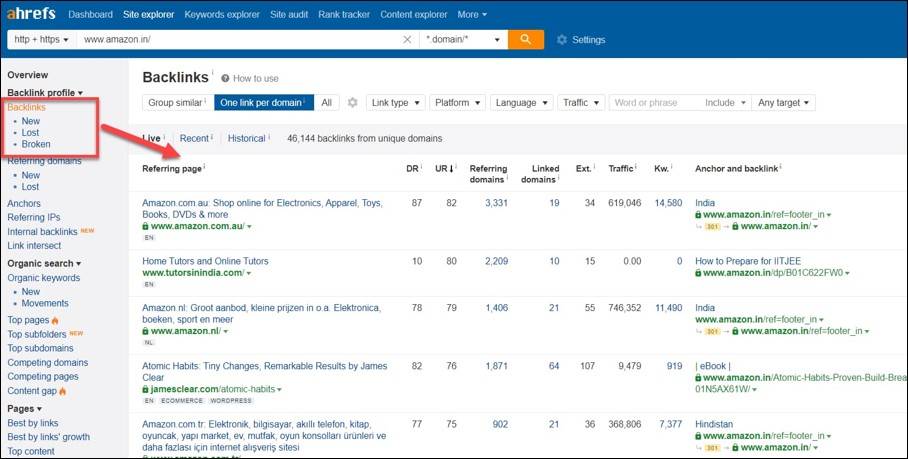
Once you have the list of all the backlinks of your competitors, identify the common backlinks. Look for websites from which all your competitors are getting backlinks. Check these websites, and see if you can get a backlink from these websites as well.
-
Referring Domains
Analyze domains from which your competitors are getting links. Again, you can use Ahrefs to find these.
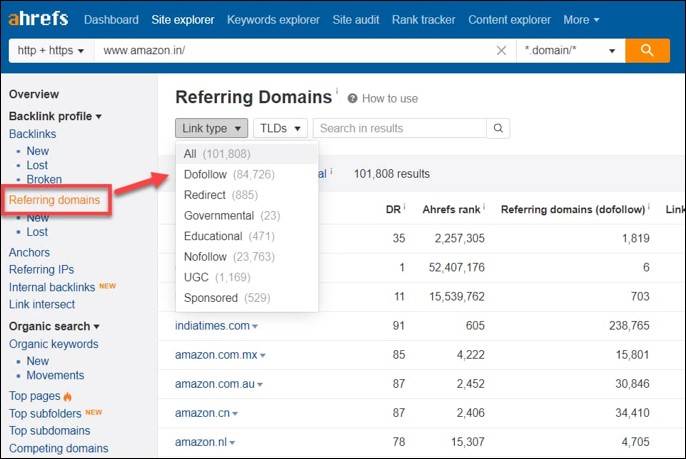
Do your competitors get backlinks from the .edu (educational) or.gov (government) domains? Such backlinks from unique domains are considered of high quality and help increase your domain authority (DA). Look for opportunities to get backlinks from such unique domains that have high domain authority. This will help you in your website’s rankings as well.
This competitor backlink analysis will help you strengthen your backlink profile and establish authority over the Internet.
-
Spot Link Bait Opportunities
Link bait content attracts high-quality backlinks by offering valuable, unique, and shareable information. Analyzing competitors’ top-linked pages helps identify content types that earn the most backlinks, such as original research, infographics, in-depth guides, or industry trends. Creating similar or better content increases your chances of gaining organic backlinks, improving authority and search rankings.
-
Identify Competitors’ Broken Pages
Finding broken pages on competitor websites presents an opportunity to gain backlinks. Use SEO tools to identify 404 error pages that previously had backlinks. Reach out to sites linking to those pages and suggest your relevant content as a replacement. This strategy helps you acquire quality backlinks, improve domain authority, and strengthen your backlink profile.
Website Architecture Analysis
Website architecture plays a significant role in your site’s rankings as well as user experience. The design layout, the CTA’s all contribute towards getting conversions. If your competitors’ website has a better UI and design, they are more likely to perform better in all aspects of the digital marketing funnel. You may want to spend some money to get the most out of your design language.
-
Internal Linking Structure
Check your competitors’ internal linking strategy. With a good internal link structure, you can boost the authority of your top pages and ensure that the Google bot crawls all your pages. This will also help your website in ranking better on the SERP.
Look closely at how your competitors are using internal links and the subsequent anchor texts. These internal links may be part of the content or within the page’s footer. Most of the e-commerce websites use the ‘Popular Searches’ or ‘People also search’ section/s to include these internal links. Analyse what keywords your competitors use as hyperlinks.
-
URL and Breadcrumb Structure
You need to keep a close eye on the competitors’ URL and breadcrumb structure. This will help you in the initial process of designing your website’s layout. The URLs of your pages should be user friendly and also include your primary keyword. And the breadcrumbs should be aimed towards providing the user with the best navigation experience.
-
Top Navigation
Your top navigation section is the most important part of your website. This is the place where users are going to interact the most.
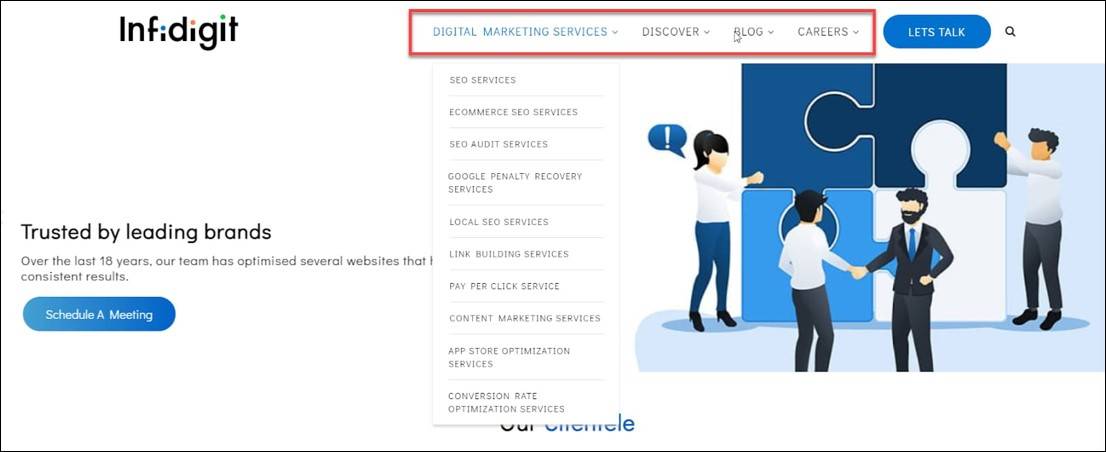
See how your competitors have set up their top navigation. This will help you get an idea of how to segment your top navigation by category. You can also study the keywords that are being used in the navigation and use this to your advantage.
-
Schema Markup
Schema markup helps search engines understand and display your content better through rich snippets like ratings, FAQs, and event details. Analyzing competitors’ schema implementation reveals opportunities to enhance your structured data. Using schema can improve CTR, visibility, and search rankings by making your listings more informative and engaging in SERPs.
Google SERP Analysis
Understanding the Google SERP and the results it shows for your keywords is extremely necessary. Enter your focus keywords in the search bar and observe the search results.
Let us understand this with a few examples:
-
Keyword ‘life insurance’
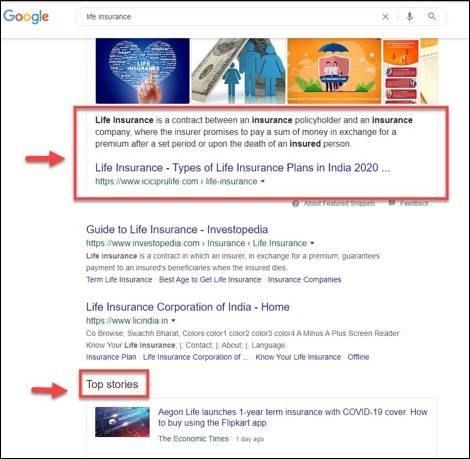
From the image above, observe the results displayed for the term ‘life insurance’. First, you have a featured snippet from ICICI. Next, you also see the ‘Top Stories’ section.
This makes it quite evident that you can target your pages to appear in featured snippets. The section ‘Top Stories’ will also take up some space on the SERP.
-
Keyword ‘paintings’

Notice the results in the Google SERP for ‘paintings’. These results are quite different from the ones displayed for the ‘life insurance’ keyword. The first result shown is the ‘Images’ section. You will also find the ‘Videos’ section below. This makes it quite evident that you need to target the ‘Images’ section. You would want to optimise the images on your website.
As you can see from the above examples, understanding Google SERP is a very important part of SEO competitor analysis. See which positions are acquired by your competitors in the SERP. This will give you a decent sense of where your website can rank in the Google SERP.
-
Monitor Competitors’ SERP Features
SERP features like featured snippets, knowledge panels, and “People Also Ask” boxes can drive significant traffic. Analyzing competitors’ presence in these features helps identify gaps and opportunities to optimize your content. Focus on structured formatting, relevant keywords, and clear answers to improve your chances of appearing in rich search results, boosting visibility and organic clicks.
Technical SEO Analysis
Technical analysis involves researching the backend technologies and the subsequent frameworks that your competitors use. It also includes taking into account their page speed and site performance metrics.
-
Page Speed
Page speed is arguably one of the most important metrics in technical SEO. Google has also confirmed it to be a ranking factor. Keep a close eye on the page speed of your competitors.
You can use Google PageSpeed Insights tool to find these metrics.

Having a better page speed than your competitors will help your websites in rankings.
-
Mobile-Friendly
With the number of mobile device users increasing day by day, it becomes extremely important for our website to be mobile-friendly. Your website should be well optimised for mobile devices. It should have a responsive layout that is easily viewable on all smartphones.
You can run your website through the Mobile-Friendly test tool.

Many times, you might be able to beat your competitors in desktop rankings but not in mobile rankings. Mobile-friendliness is an area you need to improve upon.
-
Technologies used
There are various technologies used to build websites such as Java, PHP, Ruby, Angular JS, Node JS and more. Check which technology your competitors’ website is built upon. Also, check the above-mentioned page speed and mobile friendly metrics. If any of your competitors’ websites are performing exceptionally well. This is a technology you should build your website upon.
If you still compete with your competitors, we suggest you get in touch with an SEO agency which provides advanced technical SEO services.
-
Website Performance and User Experience (UX)
A fast, user-friendly website improves SEO rankings and engagement. Analyzing competitors’ page speed, mobile responsiveness, and core web vitals helps identify areas for improvement. A well-optimized site with quick load times, intuitive navigation, and a seamless user experience keeps visitors engaged, reduces bounce rates, and boosts search visibility.
-
Core Web Vitals
Core Web Vitals measure a website’s loading speed, interactivity, and visual stability, directly impacting SEO and user experience. Analyzing competitors’ scores for Largest Contentful Paint (LCP), First Input Delay (FID), and Cumulative Layout Shift (CLS) helps identify areas where your site can improve. Optimizing these metrics enhances page performance, user satisfaction, and search rankings.
PPC and Paid Search Insights
-
Identify Competitors’ PPC Ads
Analyzing competitors’ PPC campaigns helps uncover their target keywords, ad copy, and bidding strategies. By reviewing their Google Ads, display ads, and landing pages, you can identify high-performing keywords and craft better ad strategies. This insight allows you to refine your PPC campaigns, optimize ad spend, and gain a competitive edge in paid search.
-
See What Keywords Competitors Are Bidding On
Analyzing the keywords your competitors bid on provides insights into their paid search strategy. By identifying high-performing and low-competition keywords, you can refine your PPC campaigns for better ROI. Monitoring their ad placements, CPC trends, and keyword overlap helps optimize your bidding strategy and uncover new growth opportunities in paid search.
Conclusion
We all want to beat our competitors in rankings. However, before doing that, you need to have a fair idea of what you are up against. This makes competitor analysis an integral part of any SEO strategy. Once you know your competition, you can align your SEO activities and efforts towards performing better than your competitors.
Performing competitor analysis helps you uncover hidden SEO strategies you might not have known before. It also highlights the areas of SEO that you need to improve upon. We hope this exhaustive guide helps you perform a healthy SEO competitor analysis.
FAQs about SEO Competitor Analysis
What is competitor analysis in SEO?
Competitor analysis in SEO is the process of evaluating your competitors’ strategies, keywords, backlinks, content, and technical SEO to identify opportunities for improvement. It helps businesses understand what’s working for competitors and develop a data-driven approach to outrank them in search engine results.
What are the key factors to analyze in SEO competitor research?
Key factors to analyze in SEO competitor research include:
- Keyword strategy – Identify target and ranking keywords.
- Backlink profile – Evaluate the quality and quantity of backlinks.
- Content analysis – Assess content quality, length, and structure.
- Technical SEO – Check page speed, mobile-friendliness, and Core Web Vitals.
- SERP features – Analyze competitor rankings in featured snippets and rich results.
What are the best SEO competitor analysis tools?
Some of the best SEO competitor analysis tools include:
- SEMrush – For keyword gap analysis and backlink tracking.
- Ahrefs – To analyze competitor backlinks and content strategy.
- Moz – For domain authority and keyword research.
- Google Search Console – To track keyword rankings and site performance.
- Screaming Frog – For technical SEO audits.
What is an SEO competitor analysis template?
An SEO competitor analysis template is a structured framework that helps businesses organize and compare competitor data across key SEO metrics. It typically includes sections for keyword performance, backlink analysis, content strategy, technical SEO factors, and SERP rankings, making it easier to identify strengths and weaknesses.
What are some free competitor analysis tools for SEO?
Free SEO competitor analysis tools include:
- Google Search Console – Monitors rankings and performance.
- Ubersuggest – Provides keyword and competitor insights.
- Moz Free Domain Analysis Tool – Checks domain authority and backlinks.
- Google Trends – Identifies search trends and keyword popularity.
- SEO Meta One Click – Analyzes meta tags and on-page SEO.
What is an SEO competitor analysis checklist?
An SEO competitor analysis checklist is a step-by-step guide to evaluating competitors’ SEO performance. It typically includes:
- Identifying competitors using SERPs and tools.
- Analyzing keyword gaps and opportunities.
- Evaluating backlinks for authority and relevance.
- Assessing content quality, type, and structure.
- Reviewing technical SEO factors like site speed and mobile-friendliness.
- Tracking SERP rankings and featured snippets.
This checklist helps businesses develop a strong SEO strategy based on competitor insights.
Popular Searches
How useful was this post?
0 / 5. 0


